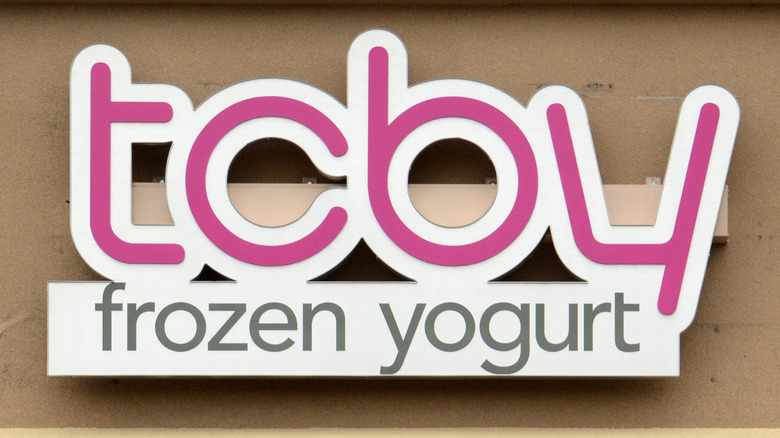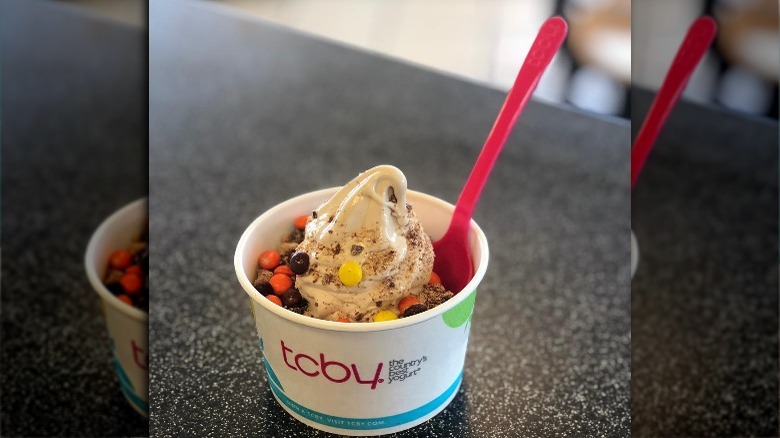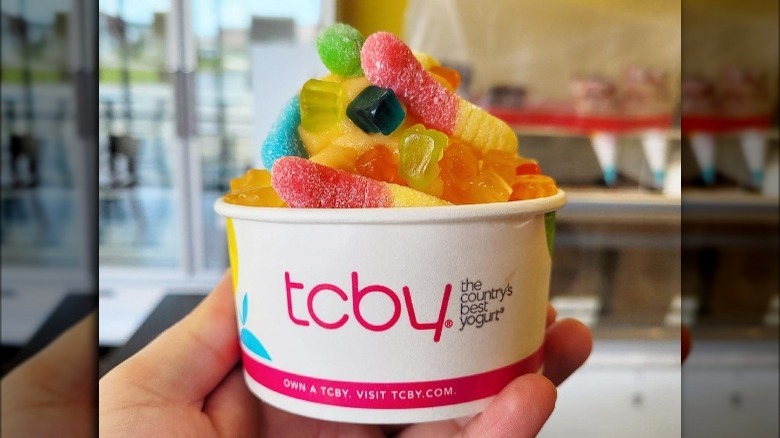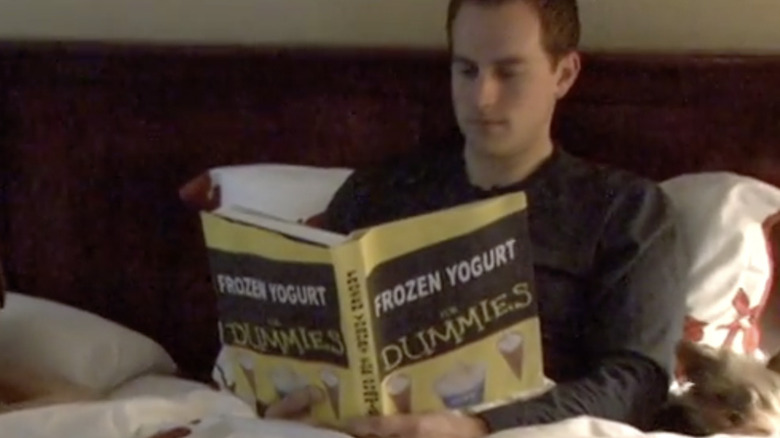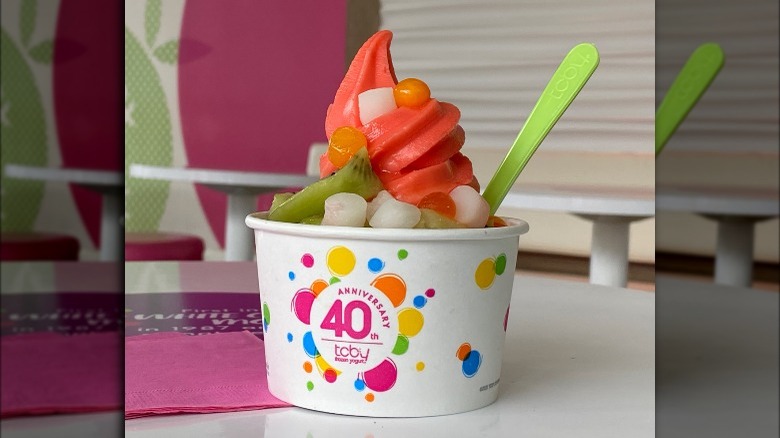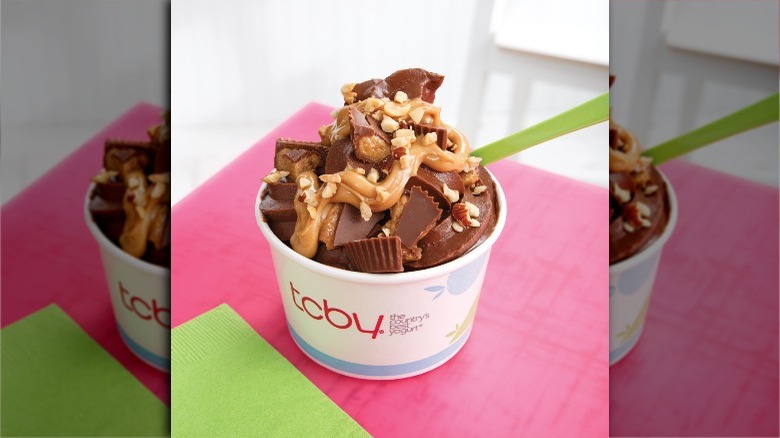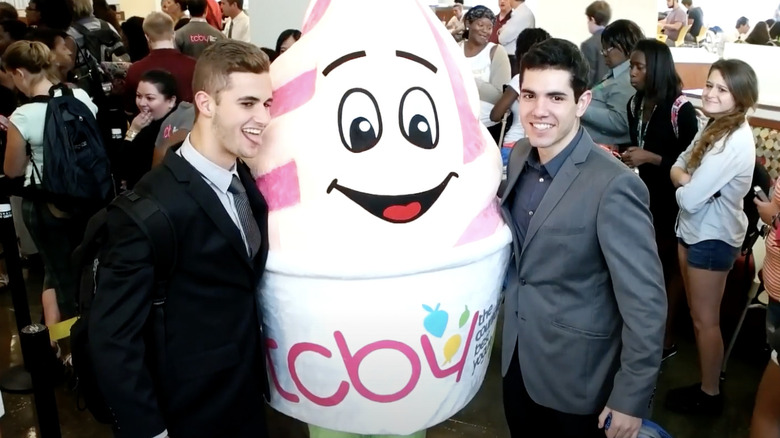The Untold Truth Of TCBY
Frozen yogurt appeared at the crossroads of the health food craze of the 1970s (a decade in which yogurt arguably played a growing culinary role in America), and the slick and capitalist spirit of the 1980s. Yet, the many people who were cutting fat and sugar out of their diets didn't make fat-and-sugar-loaded ice cream taste any less wonderful. And thanks to the work of food scientists, says Cool Desserts, along came frozen yogurt, also known as fro-yo (or "frogurt" as its inventor called it). This new treat offered a taste and texture experience similar to that of soft-serve ice cream but with significantly less fat, sugar, and calories.
At the forefront of making frozen yogurt a nationwide sensation were the purveyors of "the country's best yogurt," otherwise known as TCBY. Originating in Arkansas in 1981, the concept quickly blossomed into a chain of several hundred outlets offering almost miraculously healthy-ish frozen desserts. The company remains synonymous with frozen yogurt, despite numerous competitors and imitators.
Here's a look back at the sweet, cold, and creamy untold truth of TCBY (with toppings).
TCBY was supposed to be a time-filler for a retiree
In the 1970s, according to Funding Universe, Frank Hickingbotham was pretty busy. He ran a string of AQ Chicken franchises, a frozen pie shell company, and the Dallas-based cake mix maker Old Tyme Foods. By the early '80s, and only in his mid-forties, Hickingbotham had built up a fortune substantial enough that he considered semi-retiring — that is, walking away from all of his other businesses and taking on a new one almost as a hobby. When he was trying to figure out what to do, per the Chicago Tribune, his wife became mildly obsessed with frozen yogurt. Georgia Hickingbotham got hers at the Neiman-Marcus department store in Dallas. ”She kept telling me how delicious it was. Finally, I tried the peach yogurt and told her by no stretch of the imagination was that yogurt,” Frank Hickingbotham said. And that's how he figured out that his new hustle would be some seriously tasty frozen yogurt.
He started by going straight to the source: Hickingbotham contracted with Neiman-Marcus's fro-yo supplier, Americana Foods. In a savvy move that would limit the growth of competitors, Hickingbotham bought Americana Foods and made it a subsidiary of This Can't Be Yogurt, or TCBY, for short. In 1981 and 1982, Hickingbotham opened the first few TCBY outlets in Little Rock, Arkansas (and had his sons and son-in-law manage them). By 1983, when the company went public, there were already 41 TCBY locations. By 1987, there were 750.
What does "TCBY" really stand for?
While TCBY usually goes with just its easily memorize acronym in branding materials and store signage, those four letters do actually stand for something. Officially, "TCBY" stands for "The Country's Best Yogurt." That's been the designation since 1984, according to The Daily Meal, but in the infancy of the company, those letters referred to a few different words. When Frank Hickingbotham opened the first TCBY outlets in 1981 (per the University of Arkansas), the acronym meant "This Can't Be Yogurt." According to company lore (via Funding Universe), that's the phrase that a surprised and delighted Hickingbotham instinctively blurted out the first time he tried frozen yogurt, convinced that what he was eating had to be ice cream.
This Can't Be Yogurt wasn't the first fro-yo chain in the U.S., however. Its market entry was preceded by four years by I Can't Believe It's Yogurt, which opened in Dallas, Texas. When I Can't Believe It's Yogurt's executives learned about This Can't Be Yogurt, they sued, alleging that the name was too similar and that it could cause confusion among consumers. The courts agreed, and TCBY was forced to change its name. It didn't change the acronym, however, just the words that it stood for. And so it became the somewhat boastful shop known, for those who aren't into the whole brevity thing, as "The Country's Best Yogurt."
TCBY gave away a franchise
Over-the-top promotions are almost as iconic to fast food as burgers, fries, and soft serve. Consider how McDonald's has its popular and notorious "Monopoly" fill-in-the-board and win prizes and a million dollars game. For its part, TCBY drummed up interest and publicity for its frozen yogurt-based treats — and abundant franchising opportunities — in a novel way. And it was one that dramatically impacted the day-to-day lives of its eventual winners for years to come.
In 2009, according to QSRWeb, TCBY underwent a national search for a worthy business-minded individual to whom they would award a brand new TCBY franchise. Contestants who wished to enter "This Could Be Yours, The Great TCBY Store Giveaway," were invited to send a video essay of themselves to the frozen yogurt company. Therein, the hopefuls were to explain why they wanted to run a TCBY, and exactly how they and their location were the perfect fit for a new dairy dessert outlet. "There is no question that running your own business and being your own boss is an exciting prospect for many people," said TCBY president Michael Ward. Videos were judged on content, creativity, and overall presentation.
After sorting through submissions for months, TCBY declared a winner in 2010, according to the Northwest Arkansas Democrat Gazette. Or, rather, "winners," as the two new franchise owners were married Fayetteville, Arkansas entrepreneurs Jared and Sarah Greer. The two had previously worked in property management and pharmaceutical sales.
TCBY keeps innovating in frozen yogurt
TCBY didn't invent frozen yogurt (according to Cool Desserts, a food scientist named H.P. Hood actually did so in the 1970s), but the chain was definitely responsible for its spread and explosive popularity in the 1980s and beyond. Starting from a basis of offering a healthier alternative to fatty, sugary ice cream, TCBY continued to evolve. It introduced and pioneered many other calorie-conscious and food sensitivity-sensitive menu items as the public need or want for them grew.
TCBY has pretty much always positioned its products as at least vaguely healthy, with its frozen yogurt available in low-fat and no-sugar-added varieties for years. But in 2011, the chain unveiled its "Super Fro-Yo." According to a press release from TCBY, this new treat was fortified with vitamins A and D, along with boosts of extra protein, fiber, calcium, and gut-health-friendly probiotics.
In August 2013, according to MLive, TCBY teamed up with alternative milk producer Silk to launch what they claimed to be the first nationally-available dairy free frozen yogurt. Made from almond milk, Silk Chocolate Almond became the first lactose-free permanent addition to the TCBY menu.
TCBY customers didn't scream for some ice cream alternatives
As of 2021, TCBY has an expansive menu, offering traditional frozen yogurt varieties along with dairy-free, low-sugar, vitamin-enriched, and gluten-free options (not to mention a number of fruit and candy toppings to go along with all that). But not every new thing the company has trotted out over the years resonated with customers.
In 2010 and 2011, according to GlobeNewswire, the frozen yogurt giant ironically introduced regular, non-frozen yogurt to its stores. It was TCBY's attempt to forge a presence in the lucrative but competitive breakfast sector of fast food. TCBY attempted to enter said market with Yovana-branded yogurt cups, yogurt topped with berries, and yogurt parfaits, all positioned as a healthier alternative to the sorts of egg and bacon sandwiches offered by the other guys. After some successful test marketing and some national availability, the Yovana yogurt eventually disappeared from TCBY outlets.
In 2012, TCBY responded to the boom in relatively thick Greek-style yogurt with a variety of Greek-style frozen yogurt flavors. TCBY was the first national chain to serve Greek fro-yo, according to a TCBY press release. And while the product would ostensibly and theoretically more closely resemble hard-packed ice cream in terms of texture, the product itself is still relatively thin. Only time will tell if it remains on the menu permanently.
TCBY might be melting
Cookies and ice cream go together very well, both in a bowl and in high-level corporate circles. In 2000, according to the Los Angeles Times, the parent company of Mrs. Fields Original Cookies purchased TCBY. According to MoneyWise, the yogurt company operated a robust string of 1,800 stores around that time, a number that soon fell hard and quickly. By 2014, only about 650 TCBY stores remained. According to TCBY, that figure more recently sits at just over 250 stores in 2021. Similarly, the chain's corporate sibling, Mrs. Fields, is down from its peak, having closed about two-thirds of its outlets.
So, what's the main reason for the faltering fortunes of most dessert emporiums (which are co-branded and take up the same restaurant and retail space in many cities)? That would be increased competition in the market sectors they pioneered. While Mrs. Fields has to contend with baked good purveyors like Auntie Anne's and Cinnabon, TCBY has proven to be a victim of its own success and innovation.
Frozen yogurt experienced an uptick in popularity in the 2010s, thanks in part to the upscale, 260-outlet-strong Pinkberry chain (per the Los Angeles Times), and more than 4,000 other frozen yogurt shops (according to the Baltimore Sun). All those new and fresh takes on fro-yo made doing business harder for TCBY, particularly when everyone's using the lower-cost self-serve operational model — which TCBY helped introduce in 2010, according to Franchise Chatter.
